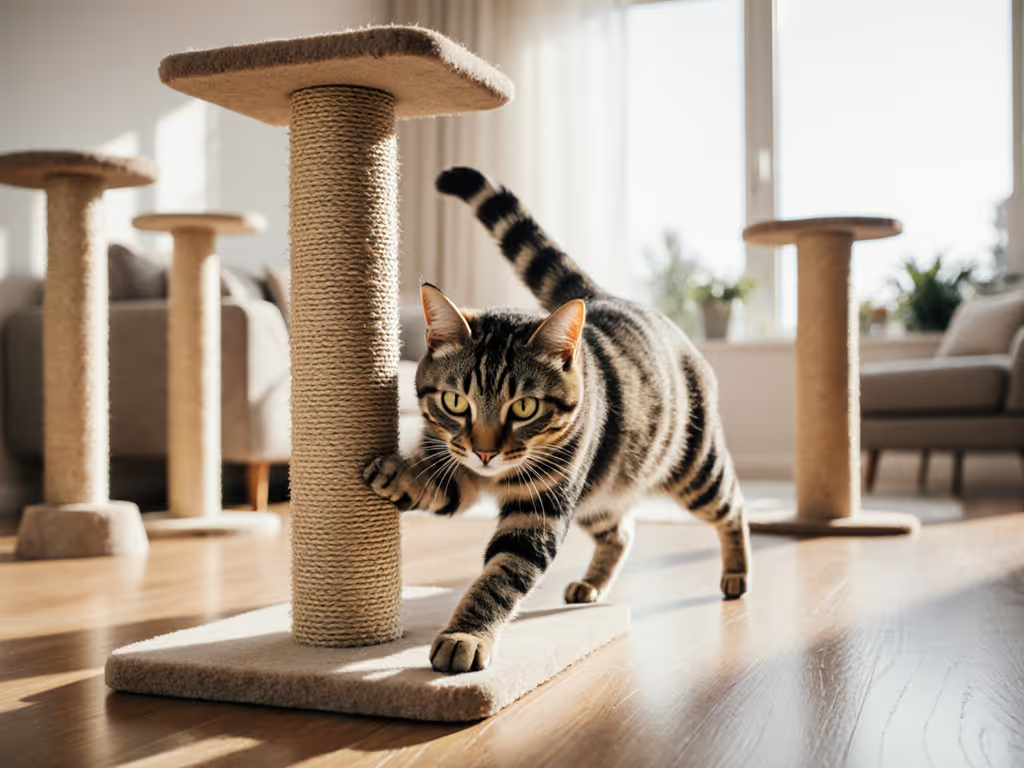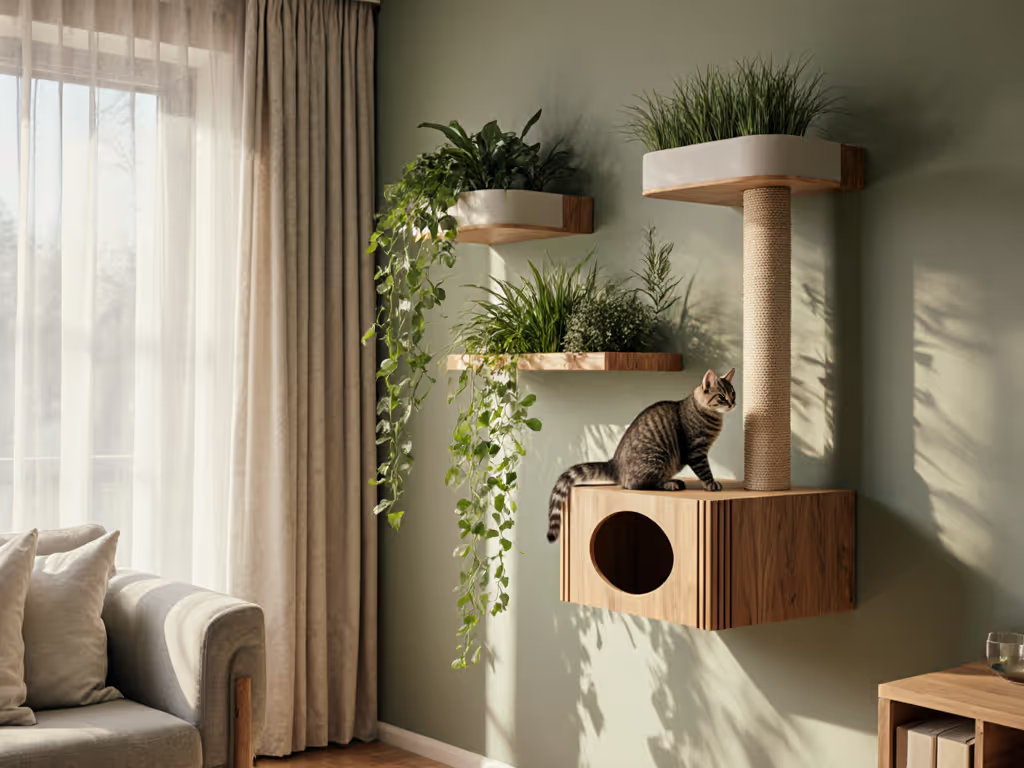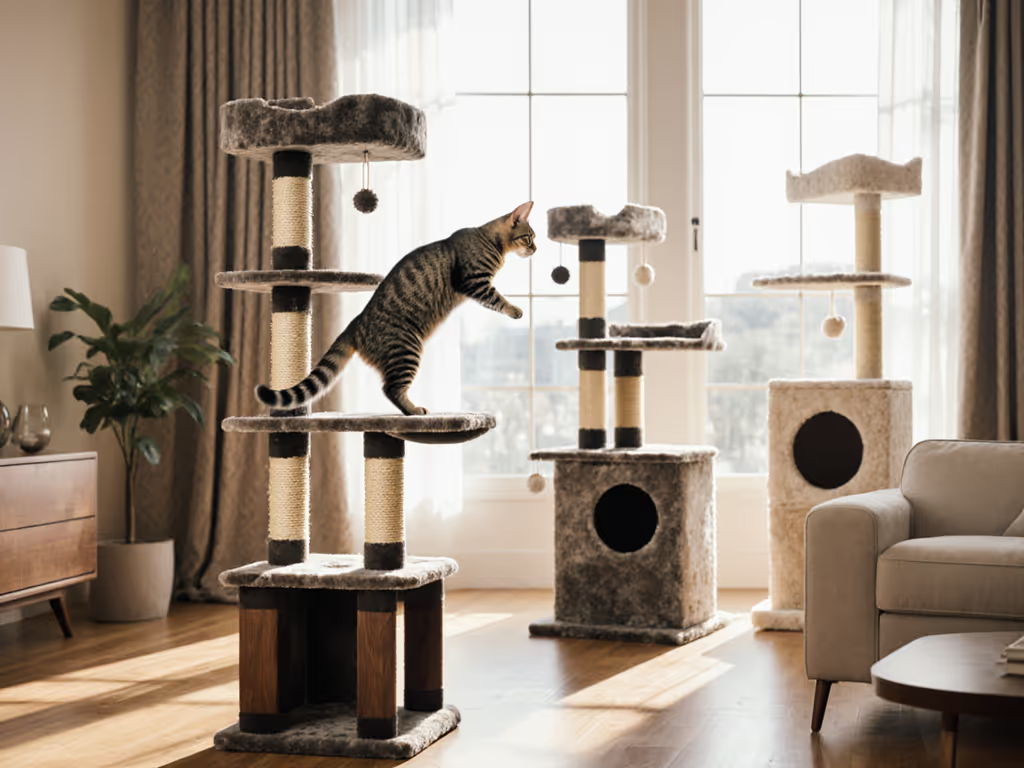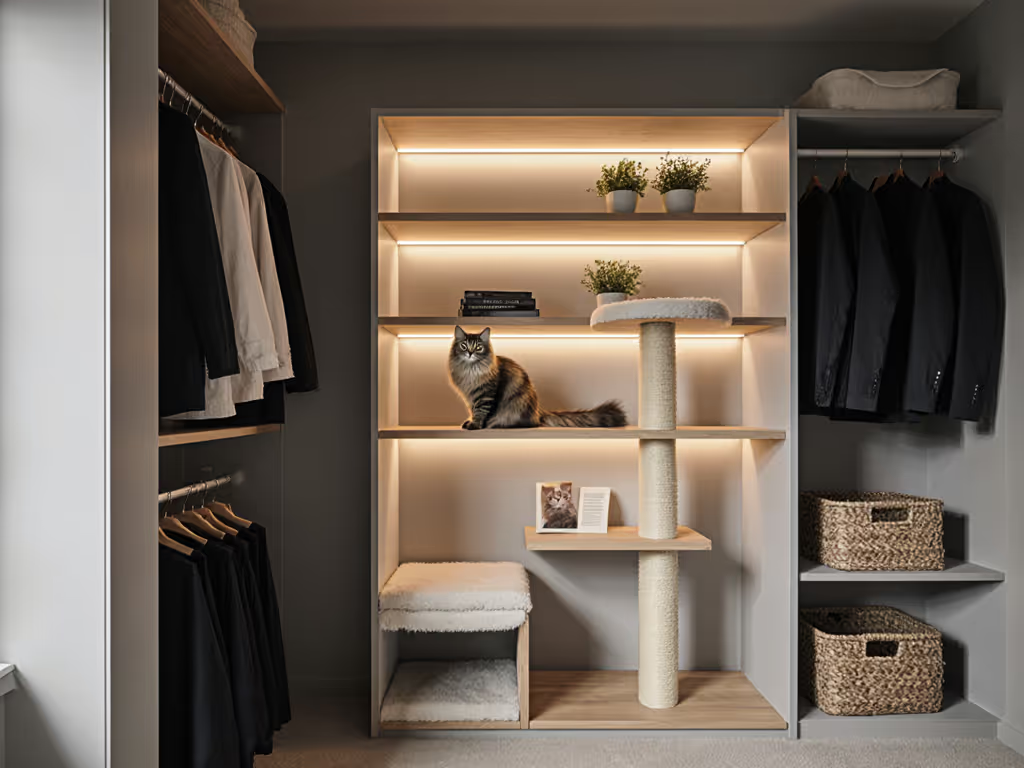
Active vs. Calm: Unique Cat Furniture Tailored to Feline Energy
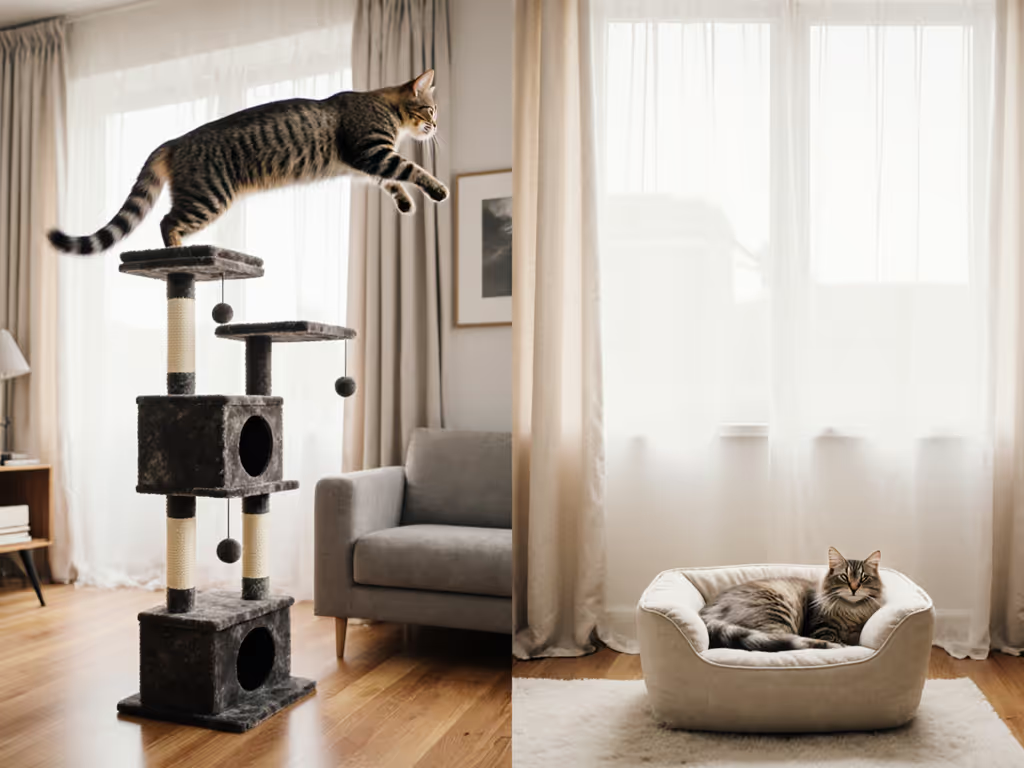
When my first apartment couldn't stretch to designer cat furniture, I didn't settle for disposable solutions. Instead, I transformed maple scraps from a neighbor's renovation into a modular cat tree wrapped in thrifted sisal. Three years later (and after multiple apartment changes), it still gets nightly use from my adventurous tabby. This experience taught me that unique cat furniture should match your cat's personality, not just your decor, and that small cat furniture can deliver big functionality when thoughtfully designed. Sustainability is durability plus joy, not deprivation, and when you honor your cat's natural energy patterns, you create spaces that spark their instincts while blending seamlessly into your home. Let me show you how to build or select furniture that works with your cat's energy rather than against it.
Step 1: Decoding Your Cat's Energy Language
Before you purchase or build anything, spend a week observing your cat's natural rhythms. High-energy felines often exhibit telltale signs: dawn patrol sprints, curtain-climbing acrobatics, or toy-chasing marathons. These cats think vertically, so they'll scale bookshelves and leap across gaps that seem impossible to us. Meanwhile, low-energy cats prefer sunbeam lounging, gentle window-watching, and cozy cubbies where they can curl up undisturbed.
Your cat's energy pattern isn't a flaw to fix: it's a blueprint for joyful living.
To accurately assess your cat's energy profile, track these specific behaviors:
- Vertical territory usage: Does your cat claim high vantage points or prefer ground-level safety?
- Play duration: Does your cat engage in extended chase sessions or brief interactive moments?
- Resting positions: Do they sprawl openly or curl tightly in enclosed spaces?
- Novelty response: Does your cat investigate new objects immediately or cautiously?
This assessment forms the foundation for feline energy-specific design: the practice of creating spaces that honor your cat's natural instincts rather than forcing them into generic solutions. For a deeper behavior-first framework, see our behavior-guided space plan. Remember, a stressed cat isn't "rebellious"; they're communicating unmet needs. Matching furniture to these energy patterns solves multiple pain points at once: reducing destructive behavior while elevating your home aesthetic.
Step 2: Building Enrichment for the Active Athlete
Materials That Move With Momentum
High-energy cats need furniture engineered for impact. Skip flimsy particleboard that wobbles with every leap. Instead, choose solid wood bases (reclaimed maple or birch work beautifully) with substantial footprints (minimum 24" x 24" for towers under 5 feet). Sisal-wrapped posts should be at least 32" tall to accommodate full stretching (vital for muscle toning and territory marking).
The SmartCat Ultimate Scratching Post gets this exactly right with its sturdy base and full-stretch height. I've seen cats use these for years without the post ever tipping, which is critical for active cat enrichment that actually endures. When your active cat has appropriate outlets, they're far less likely to target your furniture, solving that "ugly, bulky cat tree" dilemma while providing genuine cat protection furniture that safeguards both your belongings and your peace of mind.

SmartCat Ultimate Scratching Post
Designing for Dynamic Movement
Active cats thrive on varied pathways. Create levels at staggered heights (12-18" differences between platforms) to encourage strategic jumping rather than repetitive leaps. Incorporate ramps with textured surfaces for grip: 30-degree angles work best for confident climbers. Always include multiple escape routes; cats feel safest when they can observe without being cornered.
For rental-friendly solutions, wall-mounted shelves in L or zigzag patterns let even small spaces feel expansive. Position shelves near windows for bird-watching rewards, but ensure at least one route connects directly to the floor; never force your cat to jump down from heights that could risk injury. This strategic layout creates active cat enrichment that's genuinely stimulating, not just tall.
Step 3: Crafting Serene Spaces for Low-Energy Cats
Comfort Engineering for Calm Companions
Senior cats or naturally mellow felines prioritize comfort over conquest. If arthritis or mobility changes are a concern, explore our senior cat comfort solutions for low-entry, joint-friendly setups. They need low energy cat spaces with gentle access points: ramps instead of ladders, platforms within easy jumping distance. Cushion thickness matters: aim for 3-4" of high-density foam that recovers its shape after use (avoid memory foam which can trap heat).
The LESYPET small cat bed exemplifies thoughtful design for calm cats with its raised edges that provide head support and security. Its non-slip bottom keeps it stable during cuddle sessions, and the washable cover addresses the "constant struggle to clean cat hair" pain point. This isn't just small cat furniture: it is a carefully engineered comfort system that works equally well on shelves, carriers, or sofas.

LESYPET Cat Bed for Indoor Cats
Strategic Placement for Maximum Relaxation
Low-energy cats gravitate toward warm, quiet zones. Position furniture near heat sources (but not radiators) and away from high-traffic areas. Create layered comfort by placing beds slightly elevated (6-12" off the ground) for security without strain, which satisfies their instinct to observe while minimizing effort.
For cats with mobility issues, add extra grip surfaces with jute webbing or securely attached carpet remnants. Remember that "sunbeam chasing" is crucial for vitamin D absorption in indoor cats, so position resting areas where natural light moves throughout the day. These low energy cat spaces become sanctuaries where your cat can recharge without feeling excluded from household activity.
Step 4: Modular Systems for Multi-Energy Households
Adaptable Frameworks That Grow With Your Cats
When you have cats with different energy levels, unique cat furniture must be flexible. Modular systems let you create distinct zones within shared spaces: active areas higher up, calm zones nearer ground level. This eliminates the "struggle to accommodate multiple cats" pain point while keeping your home aesthetically unified. For layout strategies that prevent resource guarding and corridor conflicts, see our multi-cat territory design guide.
The Armarkat B5701 cat tree offers a brilliant middle ground with its multiple levels that cater to different preferences. Place the condo and lower perches near walls for security-loving cats, while the higher platforms serve your acrobats. What I appreciate is how the sisal-wrapped posts provide long-lasting scratching surfaces that won't need replacement every six months, which delivers true sustainability through thoughtful material choices.
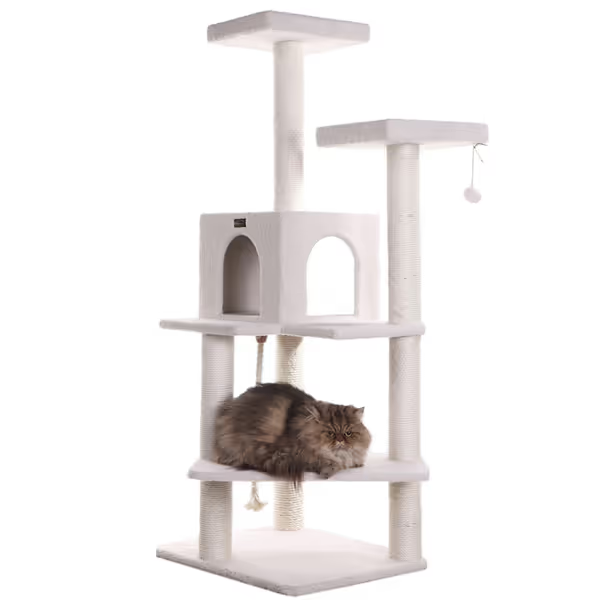
Armarkat B5701 57-Inch Cat Tree, Ivory
Budget-Friendly Customization Tips
You can enhance modularity without major expense:
- Add removable cushions: Use velcro to attach washable pads to platforms (swap thicker ones for seniors, thinner for active cats)
- Create "stepping stones": Small wall shelves between main platforms break long jumps into manageable segments
- Rotate interactive elements: Swap dangling toys weekly to maintain interest without overwhelming your space
Modular beats monolithic: this philosophy transforms furniture from static objects into evolving ecosystems that adapt as your cats' needs change. It's the ultimate solution for "finding furniture that accommodates evolving needs," plus it eliminates the "environmental impact of frequent replacements" by designing for longevity from the start.
Step 5: Sustainable Implementation That Lasts
Lifecycle Math for Smart Investment
Calculate furniture value by dividing cost by expected lifespan. That $130 cat tree lasting 10 years costs $13 annually, cheaper than a $60 tree replaced every 18 months ($40/year). Look for replaceable components: sisal wraps, cushions, and platforms should be user-serviceable. To keep those materials in top shape, follow our cat furniture cleaning guide with material-specific care tips. When materials can be renewed rather than replaced entirely, you're practicing true sustainability.
Prioritize non-toxic finishes (water-based polyurethanes or pure tung oil) that won't off-gas in your living space. These choices address "concerns about safety" while ensuring your furniture remains beautiful for years, with no yellowing or flaking that makes cheap options look battered.
Space-Smart Solutions for Small Homes
Urban dwellers need small cat furniture that works harder. Vertical space is your friend: wall-mounted systems keep floors clear while satisfying climbing instincts. My favorite frugal hack? Repurpose IKEA shelves with added sisal and carpet remnants for multi-functional cat highways that blend with your decor.
Spend with intention; let materials and modularity do the work. Every piece should serve multiple purposes: scratching surface + perch, hideaway + observation point, ramp + resting spot. This approach solves the "cluttered living space" pain point while delivering the "harmonious living space" outcome you desire.
Create Joy Through Thoughtful Design
Your cat's furniture should spark as much delight in you as it does in them. When you match pieces to your cat's energy profile, you're not just solving behavioral issues, you're creating opportunities for daily joy. That leap toward a new platform, the contented stretch on a perfectly positioned post, the morning sunbeam ritual in their favorite nook: these moments become woven into your shared life.
Start with one well-chosen piece that honors your cat's natural instincts. Watch how they interact with it. Notice what works and what doesn't. Then build from there, always keeping your home's flow and your cat's comfort in mind. For more inspiration on creating spaces that serve both cats and humans beautifully, explore our curated collection of sustainable cat furniture solutions that grow with your feline family. After all, the best furniture isn't just used: it is loved.

